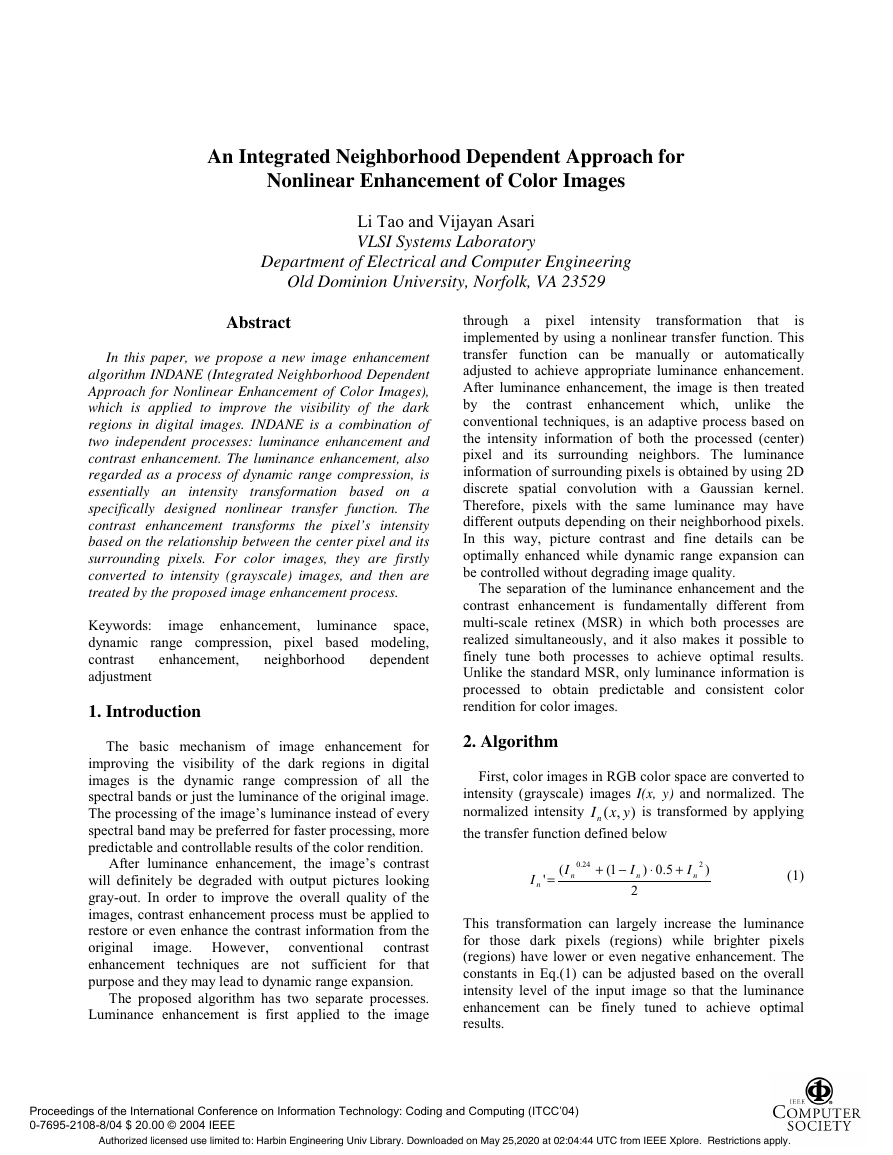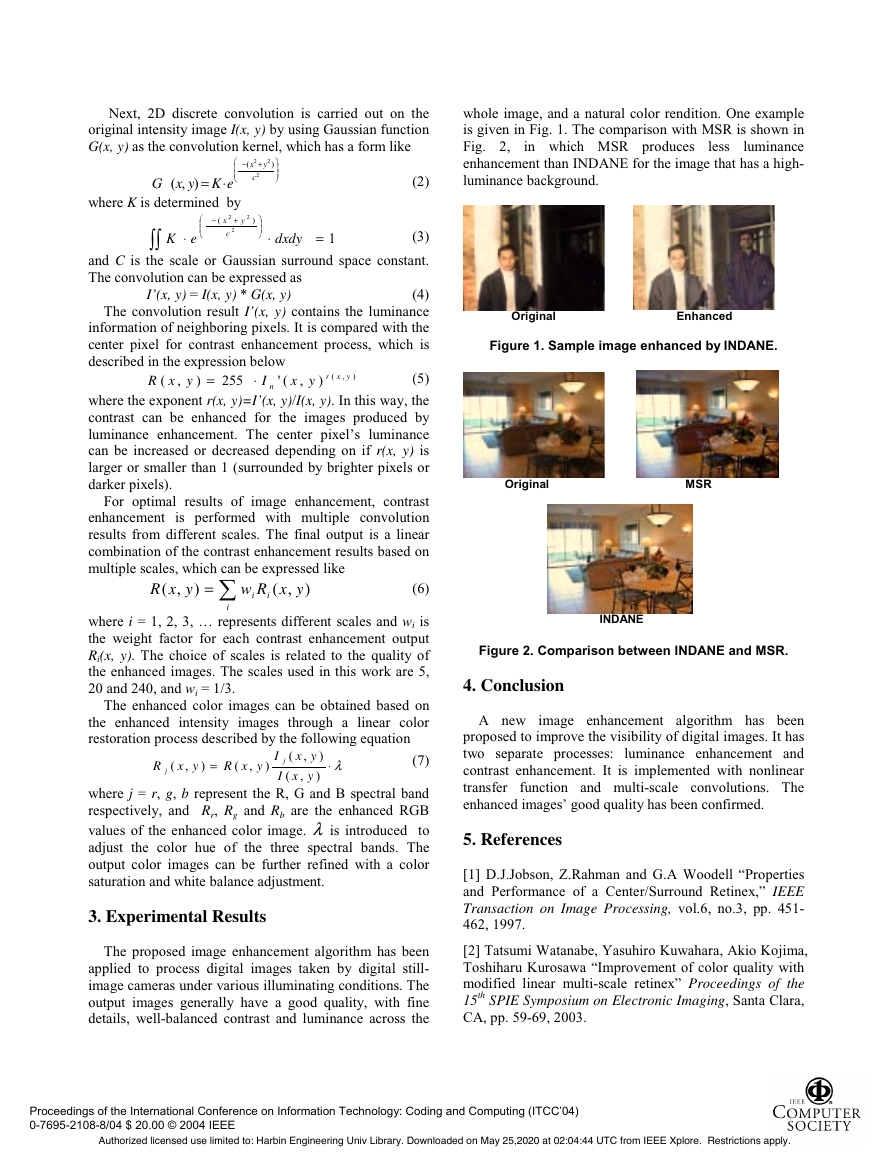An Integrated Neighborhood Dependent Approach for
Nonlinear Enhancement of Color Images
Li Tao and Vijayan Asari
VLSI Systems Laboratory
Department of Electrical and Computer Engineering
Old Dominion University, Norfolk, VA 23529
Abstract
In this paper, we propose a new image enhancement
algorithm INDANE (Integrated Neighborhood Dependent
Approach for Nonlinear Enhancement of Color Images),
which is applied to improve the visibility of the dark
regions in digital images. INDANE is a combination of
two independent processes: luminance enhancement and
contrast enhancement. The luminance enhancement, also
regarded as a process of dynamic range compression, is
essentially an
transformation based on a
specifically designed nonlinear transfer function. The
contrast enhancement transforms the pixel’s intensity
based on the relationship between the center pixel and its
surrounding pixels. For color images, they are firstly
converted to intensity (grayscale) images, and then are
treated by the proposed image enhancement process.
intensity
image enhancement,
space,
Keywords:
dynamic range compression, pixel based modeling,
contrast
dependent
adjustment
neighborhood
enhancement,
luminance
1. Introduction
The basic mechanism of image enhancement for
improving the visibility of the dark regions in digital
images is the dynamic range compression of all the
spectral bands or just the luminance of the original image.
The processing of the image’s luminance instead of every
spectral band may be preferred for faster processing, more
predictable and controllable results of the color rendition.
After luminance enhancement, the image’s contrast
will definitely be degraded with output pictures looking
gray-out. In order to improve the overall quality of the
images, contrast enhancement process must be applied to
restore or even enhance the contrast information from the
contrast
original
enhancement
that
purpose and they may lead to dynamic range expansion.
techniques are not sufficient for
image. However,
conventional
The proposed algorithm has two separate processes.
Luminance enhancement is first applied to the image
that
intensity
transformation
the contrast enhancement which, unlike
through a pixel
is
implemented by using a nonlinear transfer function. This
transfer function can be manually or automatically
adjusted to achieve appropriate luminance enhancement.
After luminance enhancement, the image is then treated
by
the
conventional techniques, is an adaptive process based on
the intensity information of both the processed (center)
pixel and its surrounding neighbors. The luminance
information of surrounding pixels is obtained by using 2D
discrete spatial convolution with a Gaussian kernel.
Therefore, pixels with the same luminance may have
different outputs depending on their neighborhood pixels.
In this way, picture contrast and fine details can be
optimally enhanced while dynamic range expansion can
be controlled without degrading image quality.
The separation of the luminance enhancement and the
contrast enhancement is fundamentally different from
multi-scale retinex (MSR) in which both processes are
realized simultaneously, and it also makes it possible to
finely tune both processes to achieve optimal results.
Unlike the standard MSR, only luminance information is
processed to obtain predictable and consistent color
rendition for color images.
2. Algorithm
First, color images in RGB color space are converted to
intensity (grayscale) images I(x, y) and normalized. The
is transformed by applying
normalized intensity
the transfer function defined below
yxI n
),(
24.0
(
I
n
+
−
1(
=
I
n
'
I
n
2
⋅
5.0)
+
I
n
2
)
(1)
This transformation can largely increase the luminance
for those dark pixels (regions) while brighter pixels
(regions) have lower or even negative enhancement. The
constants in Eq.(1) can be adjusted based on the overall
intensity level of the input image so that the luminance
enhancement can be finely tuned to achieve optimal
results.
Proceedings of the International Conference on Information Technology: Coding and Computing (ITCC’04)
0-7695-2108-8/04 $ 20.00 © 2004 IEEE
Authorized licensed use limited to: Harbin Engineering Univ Library. Downloaded on May 25,2020 at 02:04:44 UTC from IEEE Xplore. Restrictions apply.
�
Next, 2D discrete convolution is carried out on the
original intensity image I(x, y) by using Gaussian function
G(x, y) as the convolution kernel, which has a form like
⋅=
eKyxG
),(
§
¨
¨
©
2
y
)
−
(
+
2
2
x
c
·
¸
¸
¹
(2)
where K is determined by
+
y
2
−
(
2
x
c
§
¨¨
©
³³
⋅
eK
2
)
·
¸¸
¹
⋅
dxdy
=
1
(3)
and C is the scale or Gaussian surround space constant.
The convolution can be expressed as
I’(x, y) = I(x, y) * G(x, y) (4)
The convolution result I’(x, y) contains the luminance
information of neighboring pixels. It is compared with the
center pixel for contrast enhancement process, which is
described in the expression below
('
(5)
where the exponent r(x, y)=I’(x, y)/I(x, y). In this way, the
contrast can be enhanced for the images produced by
luminance enhancement. The center pixel’s luminance
can be increased or decreased depending on if r(x, y) is
larger or smaller than 1 (surrounded by brighter pixels or
darker pixels).
yxR
yx
255
r
()
=
yx
(
)
I
,
)
⋅
,
,
n
For optimal results of image enhancement, contrast
enhancement is performed with multiple convolution
results from different scales. The final output is a linear
combination of the contrast enhancement results based on
multiple scales, which can be expressed like
yxR
,(
)
¦=
yxRw
,(
)
(6)
i
i
i
where i = 1, 2, 3, … represents different scales and wi is
the weight factor for each contrast enhancement output
Ri(x, y). The choice of scales is related to the quality of
the enhanced images. The scales used in this work are 5,
20 and 240, and wi = 1/3.
The enhanced color images can be obtained based on
the enhanced intensity images through a linear color
restoration process described by the following equation
R
j
(
yx
,
)
=
yxR
(
,
)
I
yx
,
(
)
j
yxI
)
(
,
λ⋅
(7)
where j = r, g, b represent the R, G and B spectral band
respectively, and Rr, Rg and Rb are the enhanced RGB
values of the enhanced color image. λ is introduced to
adjust the color hue of the three spectral bands. The
output color images can be further refined with a color
saturation and white balance adjustment.
3. Experimental Results
The proposed image enhancement algorithm has been
applied to process digital images taken by digital still-
image cameras under various illuminating conditions. The
output images generally have a good quality, with fine
details, well-balanced contrast and luminance across the
whole image, and a natural color rendition. One example
is given in Fig. 1. The comparison with MSR is shown in
Fig. 2,
luminance
enhancement than INDANE for the image that has a high-
luminance background.
in which MSR produces
less
Original
Enhanced
Figure 1. Sample image enhanced by INDANE.
Original
MSR
INDANE
Figure 2. Comparison between INDANE and MSR.
4. Conclusion
A new
image enhancement algorithm has been
proposed to improve the visibility of digital images. It has
two separate processes: luminance enhancement and
contrast enhancement. It is implemented with nonlinear
transfer function and multi-scale convolutions. The
enhanced images’ good quality has been confirmed.
5. References
[1] D.J.Jobson, Z.Rahman and G.A Woodell “Properties
and Performance of a Center/Surround Retinex,” IEEE
Transaction on Image Processing, vol.6, no.3, pp. 451-
462, 1997.
[2] Tatsumi Watanabe, Yasuhiro Kuwahara, Akio Kojima,
Toshiharu Kurosawa “Improvement of color quality with
modified linear multi-scale retinex” Proceedings of the
15th SPIE Symposium on Electronic Imaging, Santa Clara,
CA, pp. 59-69, 2003.
Proceedings of the International Conference on Information Technology: Coding and Computing (ITCC’04)
0-7695-2108-8/04 $ 20.00 © 2004 IEEE
Authorized licensed use limited to: Harbin Engineering Univ Library. Downloaded on May 25,2020 at 02:04:44 UTC from IEEE Xplore. Restrictions apply.
�




 2023年江西萍乡中考道德与法治真题及答案.doc
2023年江西萍乡中考道德与法治真题及答案.doc 2012年重庆南川中考生物真题及答案.doc
2012年重庆南川中考生物真题及答案.doc 2013年江西师范大学地理学综合及文艺理论基础考研真题.doc
2013年江西师范大学地理学综合及文艺理论基础考研真题.doc 2020年四川甘孜小升初语文真题及答案I卷.doc
2020年四川甘孜小升初语文真题及答案I卷.doc 2020年注册岩土工程师专业基础考试真题及答案.doc
2020年注册岩土工程师专业基础考试真题及答案.doc 2023-2024学年福建省厦门市九年级上学期数学月考试题及答案.doc
2023-2024学年福建省厦门市九年级上学期数学月考试题及答案.doc 2021-2022学年辽宁省沈阳市大东区九年级上学期语文期末试题及答案.doc
2021-2022学年辽宁省沈阳市大东区九年级上学期语文期末试题及答案.doc 2022-2023学年北京东城区初三第一学期物理期末试卷及答案.doc
2022-2023学年北京东城区初三第一学期物理期末试卷及答案.doc 2018上半年江西教师资格初中地理学科知识与教学能力真题及答案.doc
2018上半年江西教师资格初中地理学科知识与教学能力真题及答案.doc 2012年河北国家公务员申论考试真题及答案-省级.doc
2012年河北国家公务员申论考试真题及答案-省级.doc 2020-2021学年江苏省扬州市江都区邵樊片九年级上学期数学第一次质量检测试题及答案.doc
2020-2021学年江苏省扬州市江都区邵樊片九年级上学期数学第一次质量检测试题及答案.doc 2022下半年黑龙江教师资格证中学综合素质真题及答案.doc
2022下半年黑龙江教师资格证中学综合素质真题及答案.doc